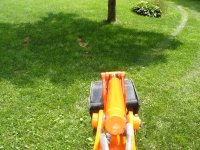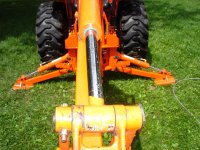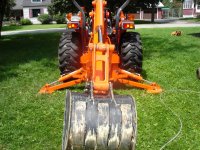grizzjeeper
Bronze Member
Last week I posted about the dipperstick arm twisting on my BH75 backhoe with less than 10 hours on it. The second failure in a year. The more I think about how this couls have happened under its own power, how fragile this must be and reading comments from others with thousands of hours with 0 breaks, I have determined there must be an issue with MY hoe. I mean I have barely used it...
The only conclusion that I can even come close to understanding the amount of damage done to the backhoe would be the amount of play in the dipper stick pin. I realize the ends of the pin are snug but the center section is not, possibly the hole is/was machines incorrectly? The key here is the amount of play that was there couldn’t possibly be from wear as the amount of hours does not depict that so I have to lean on the idea that something wasn’t right from the beginning. The more I think about this the more I feel this may be the cause. If there is lateral movement in the dipper stick arm then the geometry has changed, and I do not know how much the geometry can change before the design is overcome by the unexpected angle of pressure put forth. I feel that if the arm can twist to the left from a sloppy middle connect and you apply pressure the propensity for the arm to continue in that direction is greatly increased.
Now this leads to my next theory, is it possible that same sloppiness is what caused the other cylinder to break? I mean it’s the same idea just on the other end. That cylinder is pushing on an arm that has lateral movement and I know that the rod cannot have much movement before it breaks. I know there was an issue with those cylinders breaking but I now wonder if say there was a batch or arms that came out with pin hole’s inside diameter out of spec, subsequently creating a separate problem? Any thoughts on this?
The only conclusion that I can even come close to understanding the amount of damage done to the backhoe would be the amount of play in the dipper stick pin. I realize the ends of the pin are snug but the center section is not, possibly the hole is/was machines incorrectly? The key here is the amount of play that was there couldn’t possibly be from wear as the amount of hours does not depict that so I have to lean on the idea that something wasn’t right from the beginning. The more I think about this the more I feel this may be the cause. If there is lateral movement in the dipper stick arm then the geometry has changed, and I do not know how much the geometry can change before the design is overcome by the unexpected angle of pressure put forth. I feel that if the arm can twist to the left from a sloppy middle connect and you apply pressure the propensity for the arm to continue in that direction is greatly increased.
Now this leads to my next theory, is it possible that same sloppiness is what caused the other cylinder to break? I mean it’s the same idea just on the other end. That cylinder is pushing on an arm that has lateral movement and I know that the rod cannot have much movement before it breaks. I know there was an issue with those cylinders breaking but I now wonder if say there was a batch or arms that came out with pin hole’s inside diameter out of spec, subsequently creating a separate problem? Any thoughts on this?



